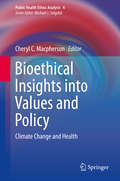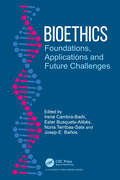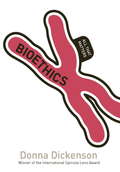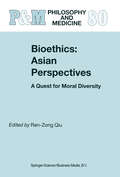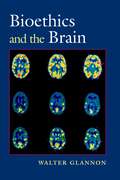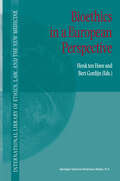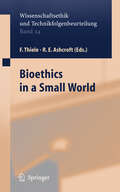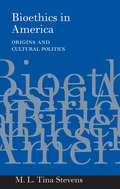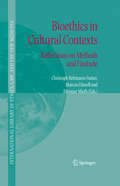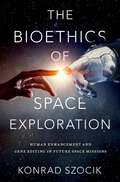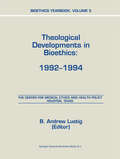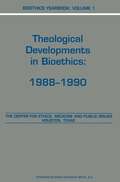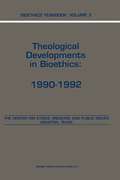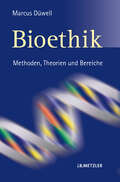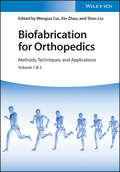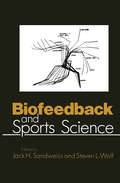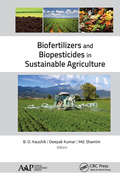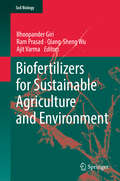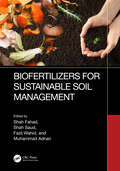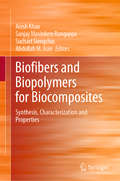- Table View
- List View
Bioethical Insights into Values and Policy: Climate Change and Health (Public Health Ethics Analysis #4)
by Cheryl C. MacphersonChanges in earth’s atmosphere, oceans, soil, weather patterns, and ecosystems are well documented by countless scientific disciplines. These manifestations of climate change harm public health. Given their goals and social responsibilities, influential health organizations recognize health impacts compounded by geography, social values, social determinants of health, health behaviors, and relationships between humans and environments primarily described in feminist ethics and environmental ethics. Health impacts are relevant to, but seldom addressed in bioethics, global health, public policy, or health or environmental policy. This book is the first to describe cultural, geographic, and socioeconomic factors that influence the regional significance of these impacts and frame them for bioethics and policy analyses.
Bioethics: Foundations, Applications and Future Challenges
by Irene Cambra-Badii Ester Busquets-Alibés Terribas-Sala Núria Josep-E. BañosThe aim of this book is to introduce and discuss bioethics in a three-synergistic way: from the foundations to the current debates in relation to healthcare and social bioethics, and thereafter the possible future challenges. In this sense, the target audience can be from diverse disciplines: life and medical sciences, law, philosophy, psychology, and education. The book will be useful to high school students, in their first contacts with bioethics, college students, teachers and researchers, and the general public interested in these controversial debates of the past, present and future of bioethics.
Bioethics: All That Matters Enhanced Apple (All That Matters #39)
by Donna DickensonIn this book:Donna Dickenson - Winner of the International Spinoza Lens AwardShould we do what ever science lets us do?Bioethics: All That Matters, new developments in biotechnology like genetics, stem cell research and artificial reproduction arouse both our greatest hopes and our greatest fears. Many people invest the new biotechnology with all the aspirations and faith once accorded to religious salvation. But does everyone benefit equally from scientific progress? Commercialised modern biomedicine runs the risk of exploiting vulnerable groups, from Indian 'surrogate' mothers to professional guinea pigs in drug research. Professor Dickenson argues that although we've entered new scientific territory, there's no need to jettison our existing moral sense. By discussing a range of real-life cases, she equips readers to make up their own minds on these important and controversial questions. Good science and good ethics needn't be contradictory.This accessible and concise book will appeal to both students and general readers, giving a fascinating introduction to a wide range of perspectives on Bioethics.All That Matters books:All books in the All That Matters series are written by world experts in their subject field. These experts work to distil a topic and get right to its heart, making the book accessible for both students and general readers. Each compelling book contains new and interesting perspectives and tells stories that matter.The Author:All That Matters - Interesting introductions to important issuesBooks on the following subjects are available from the All That Matters series: Muhammad, God, Water, Political Philosophy, Sustainability, Philosophy, Intelligence, Love, Russian Revolution, War, and Creativity.To find out more visit: www.allthatmattersbooks.com
Bioethics: A Quest for Moral Diversity (Philosophy and Medicine #80)
by Ren-Zong QiuThis is the first volume on bioethics all contributors of which are exclusively non-western scholars. The book unfolds a rich and colorful picture and addresses thorny bioethical issues from comprehensive Asian perspectives and different from the western paradigm of bioethics. It is of interest to senior undergraduate and graduate students, philosophers, physicians, scholars of Asian and culture studies, geneticists, sinologists, medical anthropologists, health administrators, and health officials.
Bioethics: Foundations, Applications and Future Challenges
The aim of this book is to introduce and discuss bioethics in a three-synergistic way: from the foundations to the current debates in relation to healthcare and social bioethics, and thereafter the possible future challenges. In this sense, the target audience can be from diverse disciplines: life and medical sciences, law, philosophy, psychology, and education. The book will be useful to high school students, in their first contacts with bioethics, college students, teachers and researchers, and the general public interested in these controversial debates of the past, present and future of bioethics.
Bioethics in a European Perspective (International Library of Ethics, Law, and the New Medicine #8)
by H. A. Ten Have Bert GordijnThis book gives an overview of the most salient themes in present-day bioethics. The book focuses on perspectives typical for the European context. This highlights not only particular bioethical themes such as social justice, choices in health care, and health policy (e.g., in post-communist countries), it also emphasizes specific approaches in ethical theory, in relation to Continental philosophies such as phenomenology and hermeneutics.
Bioethics in America: Origins and Cultural Politics
by M. L. StevensIn Bioethics in America, Tina Stevens challenges the view that the origins of the bioethics movement can be found in the 1960s, a decade mounting challenges to all variety of authority. Instead, Stevens sees bioethics as one more product of a "centuries-long cultural legacy of American ambivalence toward progress," and she finds its modern roots in the responsible science movement that emerged following detonation of the atomic bomb.Rather than challenging authority, she says, the bioethics movement was an aid to authority, in that it allowed medical doctors and researchers to proceed on course while bioethicists managed public fears about medicine's new technologies. That is, the public was reassured by bioethical oversight of biomedicine; in reality, however, bioethicists belonged to the same mainstream that produced the doctors and researchers whom the bioethicists were guiding.
Bioethics in Cultural Contexts: Reflections on Methods and Finitude (International Library of Ethics, Law, and the New Medicine #28)
by Christoph Rehmann-Sutter Marcus Düwell Dietmar MiethCHRISTOPH REHMANN-SUTTER, MARCUS DÜWELL, DIETMAR MIETH When we placed “finitude”, “limits of human existence” as a motto over a round of discussion on biomedicine and bioethics (which led to this collection of essays) we did not know how far this would lead us into methodological quandaries. However, we felt intuitively that an interdisciplinary approach including social and cultural sciences would have an advantage over a solely disciplinary (philosophical or theological) analysis. Bioethics, if it is to have adequate discriminatory power, should include sensitivity to the cultural contexts of biomedicine, and also to the cultural contexts of bioethics itself. Context awareness, of course, is not foreign to philosophical or theological bioethics, for the simple reason that the issues tackled in the debates (as in other fields of ethics) could not be adequately understood outside their contexts. Moral issues are always accompanied by contexts. When we try to unpack them – which is necessary to make them accessible to ethical discussion – we are regularly confronted with the fact that in removing too much of the context we do not clarify an issue, but make it less comprehensible. The context – at least some essential parts of it – is intrinsic to the issue. Unpacking in ethics is therefore a different procedure. It does not mean peeling the context off, but rather identifying which contextual elements are essential for an understanding of the key moral aspects of the issue, and explaining how they establish its particular character.
The Bioethics of Space Exploration
by Konrad SzocikThe first book devoted to the bioethics of the space-mission environment, The Bioethics of Space Exploration explores the ethical status of possible biomedical challenges in future long-term space missions. Konrad Szocik thoroughly examines arguments favoring and opposing human enhancement, accompanied by somatic and germline gene editing, methodology of space-mission bioethics, and moral bioenhancement. In particular, the three main types of space missions--scientific missions, commercial missions, and space colonization missions--prompt different bioethical discussions and levels of human involvement. Szocik also considers whether the possibility of saving humanity through space colonization is compatible with ethics of quality of life and the philosophy of antinatalism. Presented from an issue-driven and case-driven perspective, The Bioethics of Space Exploration highlights the utility of different normative systems for philosophers, ethicists, and social scientists alike. For any reader interested in the broader humanistic and social approach to space missions, these insightful discussions provide a new perspective into the future of space missions and the potential for radical biomedical technologies.
The Bioethics of Space Exploration
by Konrad SzocikThe first book devoted to the bioethics of the space-mission environment, The Bioethics of Space Exploration explores the ethical status of possible biomedical challenges in future long-term space missions. Konrad Szocik thoroughly examines arguments favoring and opposing human enhancement, accompanied by somatic and germline gene editing, methodology of space-mission bioethics, and moral bioenhancement. In particular, the three main types of space missions--scientific missions, commercial missions, and space colonization missions--prompt different bioethical discussions and levels of human involvement. Szocik also considers whether the possibility of saving humanity through space colonization is compatible with ethics of quality of life and the philosophy of antinatalism. Presented from an issue-driven and case-driven perspective, The Bioethics of Space Exploration highlights the utility of different normative systems for philosophers, ethicists, and social scientists alike. For any reader interested in the broader humanistic and social approach to space missions, these insightful discussions provide a new perspective into the future of space missions and the potential for radical biomedical technologies.
Bioethics Yearbook: Theological Developments in Bioethics: 1992–1994 (Bioethics Yearbook #5)
by B. AndrewLustigAs the field of bioethics has matured, increasing attention is being paid to how bioethical issues are treated in different moral and religious traditions and in different regions of the world. It is often difficult, however, to obtain timely information about these matters. The Bioethics Yearbook series analyzes how such issues as new reproductive techniques, abortion, maternal-fetal conflicts, care of seriously ill newborns, consent, confidentiality, equitable access, cost-containment, withholding and withdrawing treatment, euthanasia, the definition of death, and organ transplantation are being discussed in different religions and regions. Volume 5 discusses theological developments from 1992 to 1994 in Anglican, Baptist, Catholic, Hindu, Jehovah's Witness, Jewish, Latter-Day Saint, Lutheran, Methodist, Muslim, Pentecostal, and Presbyterian traditions.
Bioethics Yearbook: Theological Developments in Bioethics: 1988–1990 (Bioethics Yearbook #1)
by Thomas J. Bole Laurence B. McCullough H. TristramEngelhardt B. AndrewLustig Baruch A. BrodyAs the field of bioethics has matured, increasing attention is being paid to how bioethical issues are treated in different moral and religious traditions and in different parts of the world. It is often difficult, however, to get accurate information about these matters. The Bioethics Yearbook Series provides interested parties with analyses of how such issues as new reproductive techniques, abortion, maternal-fetal conflicts, care of seriously ill newborns, consent, confidentiality, equitable access, cost-containment, withdrawing treatment, active euthanasia, the definition of death, and organ transplantation are being discussed in these different traditions and different parts of the world. The first volume, and every second succeeding volume, will discuss developments in the Anglican, Baptist, Buddhist, Catholic, Eastern Orthodox, Hindu, Jewish, LDS, Lutheran, Methodist, Muslim, and Presbyterian Traditions. The second volume, and every second volume succeeding it, will discuss official governmental and medical society policies on these topics throughout the world.
Bioethics Yearbook: Theological Developments in Bioethics: 1990–1992 (Bioethics Yearbook #3)
by B. Andrew Lustig Baruch A. Brody H. Tristram Engelhardt Laurence B. McCulloughAs the field of bioethics has matured, increasing attention is being paid to how bioethical issues are treated in different moral and religious traditions and in different regions of the world. It is often difficult, however, to obtain accurate information about these matters. The Bioethics Yearbook series provides interested parties with analyses of how such issues as new reproductive techniques, abortion, maternal-fetal conflicts, care of seriously ill newborns, consent, confidentiality, equitable access, cost-containment, withholding and withdrawing treatment, active euthanasia, the definition of death, and organ transplantation are being discussed in different religious traditions and regions. Volume Three discusses theological developments from 1990--1992 in Anglican, Baptist, Buddhist, Catholic, Continental Protestant, Eastern Orthodox, Hindu, Jewish, Latter-Day Saint, Lutheran, Methodist, Muslim, and Presbyterian traditions. Volume Four will continue coverage of official governmental and medical society policies on these topics throughout the world.
Bioethik: Methoden, Theorien und Bereiche
by Marcus DüwellHeiß umstritten: Stammzell- und Embryonenforschung, Gentechnologie, Euthanasie. Was ist ethisch vertretbar? Marcus Düwell stellt die Diskussionen um die Grenzen menschlichen Handelns, um Leben und Natur und um den wissenschaftlichen Fortschritt auf ein philosophisches Fundament. Er erläutert Geschichte, Methoden und Begriffe der Bioethik und geht der Frage nach: Wie ist die veränderte Welt moralphilosophisch zu bewerten? Das Grundlagenwerk hilft bei der Orientierung.
Biofabrication for Orthopedics: Methods, Techniques and Applications
by Wenguo Cui Xin Zhao Shen LiuBiofabrication for Orthopedics A comprehensive overview of biofabrication techniques for orthopedics and their novel applications With an ever-increasing global population and the rise in the occurrence of orthopedic diseases amongst an aging population, it is essential for technological advances to meet this growing medical need. Orthopedic biofabrication is a cutting-edge field that seeks to produce novel clinical solutions to this mounting problem, through the incorporation of revolutionary technologies that have the potential to not only transform healthcare, but also provide highly automated and personalized patient solutions. With the advances in the discipline, there is a significant growing interest in biofabrication for orthopedics in research activity geared towards routine clinical use. Ideal for a broad readership amongst medical practitioners and scientists, Biofabrication for Orthopedics summarizes all aspects of the topic: detailed information on the technology, along with advanced developments, research progress, and future perspectives on biofabrication for orthopaedics—particularly on the potential applications for tissue engineering technologies. In doing so, the book describes the various biomaterials—natural and synthetic—use for orthopedics and discusses the many ways in which these materials can be used in all parts of the body. As such, it offers detailed information on a wide range of applications in the fields of biology and clinical and industrial manufacturing. Biofabrication for Orthopedics readers will also find: Insights into the applications of biofabrication technologies in various bodily functions Thorough discussion of different biofabrication techniques used in creating orthopedic products, like stereolithography, cell sheet and organ bioprinting, electrospinning, and microfluidics Discussion of a wide range of diverse functions, such as bone implants, skin regeneration, vascularization, meniscus remodeling, and more Biofabrication for Orthopedics is a useful reference for those in a variety of research fields like medical-related practitioners and scientists, materials science, medicine, and manufacturing, as well as the libraries who support them.
Biofabrication for Orthopedics: Methods, Techniques and Applications
by Wenguo Cui Xin Zhao Shen LiuBiofabrication for Orthopedics A comprehensive overview of biofabrication techniques for orthopedics and their novel applications With an ever-increasing global population and the rise in the occurrence of orthopedic diseases amongst an aging population, it is essential for technological advances to meet this growing medical need. Orthopedic biofabrication is a cutting-edge field that seeks to produce novel clinical solutions to this mounting problem, through the incorporation of revolutionary technologies that have the potential to not only transform healthcare, but also provide highly automated and personalized patient solutions. With the advances in the discipline, there is a significant growing interest in biofabrication for orthopedics in research activity geared towards routine clinical use. Ideal for a broad readership amongst medical practitioners and scientists, Biofabrication for Orthopedics summarizes all aspects of the topic: detailed information on the technology, along with advanced developments, research progress, and future perspectives on biofabrication for orthopaedics—particularly on the potential applications for tissue engineering technologies. In doing so, the book describes the various biomaterials—natural and synthetic—use for orthopedics and discusses the many ways in which these materials can be used in all parts of the body. As such, it offers detailed information on a wide range of applications in the fields of biology and clinical and industrial manufacturing. Biofabrication for Orthopedics readers will also find: Insights into the applications of biofabrication technologies in various bodily functions Thorough discussion of different biofabrication techniques used in creating orthopedic products, like stereolithography, cell sheet and organ bioprinting, electrospinning, and microfluidics Discussion of a wide range of diverse functions, such as bone implants, skin regeneration, vascularization, meniscus remodeling, and more Biofabrication for Orthopedics is a useful reference for those in a variety of research fields like medical-related practitioners and scientists, materials science, medicine, and manufacturing, as well as the libraries who support them.
Biofeedback and Sports Science
by Steven L. Wolf Jack H. SandweissThere is a new breed of athletic coach in the educational arena. While on speaking engagements around the world, I've en couraged coaches to jump "head first" and quickly into sports science. The reason is simple. With new electronic commu nication systems coming on the market almost daily, athletes can get valid and reliable information to help them maximize sports skills, and this information can come faster than most coaches are able to deliver. Coaches have historically rejected most sports science efforts in favor of traditional"seat of the pants" systems, but now there is a new kind of athlete who is asking questions never before presented to the coach. Professional athletes are individually seeking out sports scientists for answers to their particular problems. Stories appear daily in the media about athletes making quantum jumps in performance as a result of their association with sports scientists. The tidal wave is building and no one can stop it-not even the sporting goods industry. "High-tech" athletic equipment is now a must in nearly every sport. Large sporting goods companies have nearly gone bankrupt because of competitors' new "high-tech" prod ucts. ix X FoREWORD The tail is wagging the dog. Professional, amateur, and weekend athletes alike are demanding technical answers of our sports leaders, and they are going elsewhere if the correct answers aren't available. The number of Olympic athletes visiting our Coto Research Center in California is staggering.
Biofertilizers and Biopesticides in Sustainable Agriculture
by B. D. Kaushik Deepak Kumar ShamimThis new volume, Biofertilizers and Biopesticides in Sustainable Agriculture, presents strategies for the management of soil and crop diseases. Microbes have attracted worldwide attention due to their role in disease management and remediation of polluted soils. Taking a sustainable approach, this book explores the means of integrating various microbial management approaches to achieve the desired levels of crop yield under both conventional soils and neglected soils through the use of biopesticides and other botanicals as well as biomolecules. This book also presents a broad and updated view of molecular nitrogen fixation and phosphate-solubilizing and sulfur-transforming microbes for nutrition of crops in relation to the role of metal tolerant microbes in providing protection to plants grown in metal-contaminated soils. The preparation and application of biofertilizers, utilization of household waste materials, and use of genetically modified microorganisms (GMOs) in plant growth and development are also well discussed in the volume.
Biofertilizers and Biopesticides in Sustainable Agriculture
by B. D. Kaushik Deepak Kumar ShamimThis new volume, Biofertilizers and Biopesticides in Sustainable Agriculture, presents strategies for the management of soil and crop diseases. Microbes have attracted worldwide attention due to their role in disease management and remediation of polluted soils. Taking a sustainable approach, this book explores the means of integrating various microbial management approaches to achieve the desired levels of crop yield under both conventional soils and neglected soils through the use of biopesticides and other botanicals as well as biomolecules. This book also presents a broad and updated view of molecular nitrogen fixation and phosphate-solubilizing and sulfur-transforming microbes for nutrition of crops in relation to the role of metal tolerant microbes in providing protection to plants grown in metal-contaminated soils. The preparation and application of biofertilizers, utilization of household waste materials, and use of genetically modified microorganisms (GMOs) in plant growth and development are also well discussed in the volume.
Biofertilizers for Sustainable Agriculture and Environment (Soil Biology #55)
by Bhoopander Giri Ram Prasad Qiang-Sheng Wu Ajit VarmaThis book provides a comprehensive overview of the benefits of biofertilizers as an alternative to chemical fertilizers and pesticides.Agricultural production has increased massively over the last century due to increased use of chemical fertilizers and pesticides, but these gains have come at a price. The chemicals are not only expensive; they also reduce microbial activity in agricultural soils and accumulate in the food chain, with potentially harmful effects for humans. Accordingly, it is high time to explore alternatives and to find solutions to overcome our increasing dependence on these chemicals.Biofertilizers, which consist of plant remains, organic matter and microorganisms, might offer an alternative. They are natural, organic, biodegradable, eco-friendly and cost-effective. Further, the microbes present in the biofertilizers are important, because they produce nutrients required for plant growth (e.g., nitrogen, phosphorus, potassium), as well as substances essential for plant growth and development (e.g., auxins and cytokinins). Biofertilizers also improve the physical properties, fertility and productivity of soil, reducing the need for chemical fertilizers while maintaining high crop yield. This makes biofertilizers a powerful tool for sustainable agriculture and a sustainable environment.The book covers the latest research on biofertilizers, ranging from beneficial fungal, bacterial and algal inoculants; to microbes for bioremediation, wastewater treatment; and recycling of biodegradable municipal, agricultural and industrial waste; as well as biocontrol agents and bio-pesticides. As such, it offers a valuable resource for researchers, academics and students in the broad fields of microbiology and agriculture.
Biofertilizers for Sustainable Soil Management
by Shah Fahad Shah Saud Fazli Wahid Muhammad AdnanThe alkaline calcareous nature, high pH, salinity, heavy metals pollution, and low organic matter content of soils in many parts of the world have diminished the soil fertility and made essential nutrients unavailable to crops. To cope with the poor availability of soil nutrients, improve soil health, and feed the fast-growing global population, the farming community is using millions of tons of expensive chemical fertilizers in their fields to maintain an adequate level of nutrients for crop sustainability as well as to ensure food security. In this scenario, the exploitation of biofertilizers has become of paramount importance in the agricultural sector for their potential role in food safety and sustainable crop production. Bearing in mind the key importance of biofertilizers, this book examines the role of biofertilizers in sustainable management of soil and plant health under different conditions of the changing climate. Finally, it provides a platform for scientists and academicians all over the world to promote, share, and discuss various new issues, developments, and limitations in biofertilizers, crops, and beneficial microbes. Salient Features: Mainly focuses on the role of biofertilizers in managing soils for improving crop and vegetable yields as a substitute for chemical fertilizers. Highlights the valuable information for the mechanism of action, factors affecting, and limitations of biofertilizers in the wider ecosystem. Presents a diversity of techniques used across plant science. Designed to cater to the needs of researchers, technologists, policy makers, and undergraduates and postgraduates studying in the fields of organic agriculture, soil microbiology, soil biology, soil fertility, and fertilizers. Addresses plant responses to biofertilizers.
Biofertilizers for Sustainable Soil Management
The alkaline calcareous nature, high pH, salinity, heavy metals pollution, and low organic matter content of soils in many parts of the world have diminished the soil fertility and made essential nutrients unavailable to crops. To cope with the poor availability of soil nutrients, improve soil health, and feed the fast-growing global population, the farming community is using millions of tons of expensive chemical fertilizers in their fields to maintain an adequate level of nutrients for crop sustainability as well as to ensure food security. In this scenario, the exploitation of biofertilizers has become of paramount importance in the agricultural sector for their potential role in food safety and sustainable crop production. Bearing in mind the key importance of biofertilizers, this book examines the role of biofertilizers in sustainable management of soil and plant health under different conditions of the changing climate. Finally, it provides a platform for scientists and academicians all over the world to promote, share, and discuss various new issues, developments, and limitations in biofertilizers, crops, and beneficial microbes. Salient Features: Mainly focuses on the role of biofertilizers in managing soils for improving crop and vegetable yields as a substitute for chemical fertilizers. Highlights the valuable information for the mechanism of action, factors affecting, and limitations of biofertilizers in the wider ecosystem. Presents a diversity of techniques used across plant science. Designed to cater to the needs of researchers, technologists, policy makers, and undergraduates and postgraduates studying in the fields of organic agriculture, soil microbiology, soil biology, soil fertility, and fertilizers. Addresses plant responses to biofertilizers.
Biofibers and Biopolymers for Biocomposites: Synthesis, Characterization and Properties
by Anish Khan Sanjay Mavinkere Rangappa Suchart Siengchin Abdullah M. AsiriThis book summarizes recent developments in epoxy blends. It emphasizes new challenges for the synthesis, characterization, and properties of biofibers and biopolymers. It provides updates on all the important areas of biofibers and biopolymers in a comprehensive fashion, including synthesis, processing, characterisation and application. It provides a a one-stop reference for researchers and those working in industry and government. The book correlates macro, micro and nanostructure properties. Moreover, it provides cutting edge research from experts around the globe. The current status, trends, future directions and opportunities are discussed in detail, making the book also accessible for beginners to the subject and young researchers.
